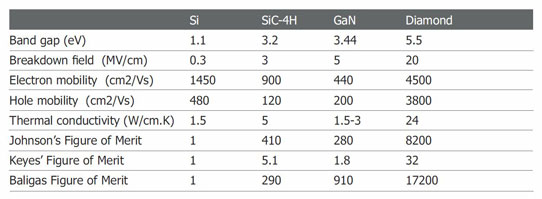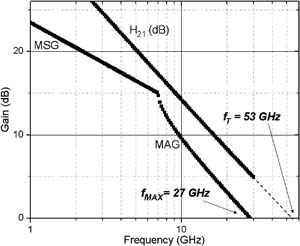- News
12 September 2012
Diamond FET with 50nm gate increases cut-off performance
University of Glasgow and Université Paris researchers have demonstrated for the first time RF performance of 50nm gate-length diamond field-effect transistors (FETs) [Stephen A. O. Russell et al, IEEE Electron Device Letters, published online 30 August 2012]. The extrinsic cut-off frequency of 53GHz is believed to be the highest reported for diamond-based transistors.
Diamond has many attractive qualities for high-power devices (Table 1) such as wide bandgap (5.47eV) and high thermal conductivity (more than 20W/cm-K). The high intrinsic carrier mobility (more than 3000cm2/V-s) also suggests high frequency application.

Table 1: Material properties and figures of merit (normalized to silicon) at room temperature. The numbers under diamond are those recently reported by E6 for electronic grade CVD diamond.
The researchers used 4.7mm squares pieces of homoepitaxial diamond supplied by Element Six. The material was treated with a surface clean in aqua regia and then sulfuric/nitric acid before hydrogen termination achieved using a plasma treatment.
Electron-beam lithography patterning of the 50nm gate-length device involved a gold sacrificial layer used to protect the hydrogen termination in some regions of the diamond surface. The aluminium gate electrode consisted of a two-finger arrangement with width 2x25μm. Oxygen plasma was used to remove the hydrogen termination in selected regions and to provide electrical isolation of individual unpassivated devices.
DC measurements gave a maximum drain current of 225mA/mm at ‑10V drain bias and zero gate potential. A gate voltage sweep between ‑2V and +4V showed good transistor action, but the maximum drain current at zero gate potential was then reduced to 170mA/mm. The maximum drain current overall was 295mA/mm at ‑2V gate potential. More negative gate biasing led to irreversible degradation of drain current performance. The degradation is attributed to “sensitivity of the hydrogen-terminated surface during processing”.
The gate leakage was 0.02mA/mm. The peak extrinsic transconductance was 78mS/mm at +0.2V gate and ‑8V drain biasing. The low transconductance value “can be attributed to a process-associated increase in access resistance at this reduced gate dimension”.
Frequency performance measurements were carried out between 1 and 30GHz resulting in a de-embedded extrinsic cut-off (fT) of 53GHz and maximum oscillation (fMAX) of 27GHz. Open and short on-wafer structures were used to correct for the parasitic effects of the coplanar waveguides used to deliver the RF signals.
The researchers used extracted parasitic behaviors to estimate an intrinsic cut-off of 90GHz. The researchers attribute the reduction to 53GHz extrinsic value as being due to a substantial increase in output conductance that perhaps is due to short channel effects and/or increased interface state density at the diamond surface.
 Figure 1: RF measurements for a 50nm gate length FET showing extracted extrinsic fT of 53 GHz and fMAX of 27 GHz.
Figure 1: RF measurements for a 50nm gate length FET showing extracted extrinsic fT of 53 GHz and fMAX of 27 GHz.
The intrinsic maximum oscillation frequency was put at 43GHz, compared with the extrinsic 27GHz. The researchers comment: “Employing a T-gate structure to minimize the lateral gate resistance across the width of the device would reduce gate resistance and greatly improve fMAX in these devices. However, a comparatively low value for output resistance will still limit fMAX at this gate length.”
Diamond Microwave Devices Ltd. (DMD) was also involved in the supply of diamond material for the research, along with Element Six. DMD is developing diamond semiconductor materials and processing technology with the aim of creating the next generation of high-power, high-frequency semiconductor devices with application in microwave power amplifiers and transmitters that are used in civil and defense systems.
Element Six (E6) is an independently managed synthetic diamond supermaterials company. Element Six is part of the De Beers Family of Companies and is co-owned by Belgium’s Umicore materials group.
www.diamondmicrowavedevices.com
The author Mike Cooke is a freelance technology journalist who has worked in the semiconductor and advanced technology sectors since 1997.
